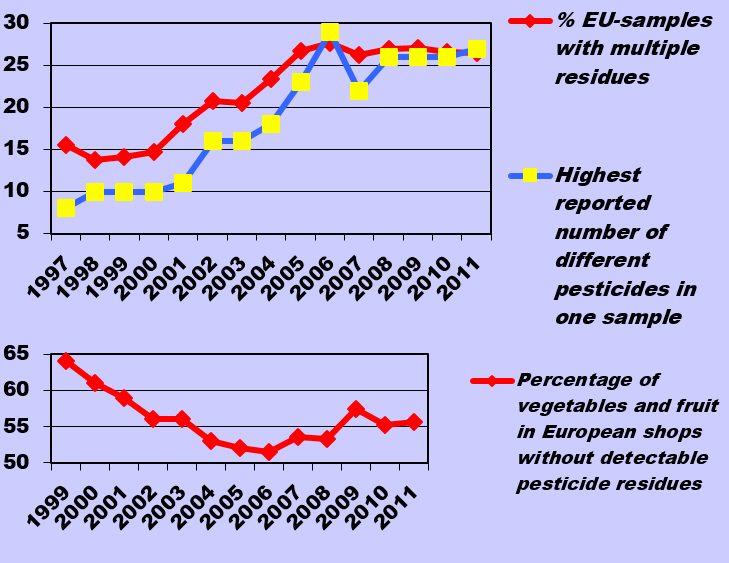Brussels
A few days ago, the European Food Safety Authority (EFSA) has released the annual report on pesticides residues in food. While the Authority claims that 93% of tested food does not exceed the Maximum Residue Level (MRL), a finer analysis of the available shows that the EFSA’s communication is misleading. European consumers are still not protected against multiple residue exposure, the accepted MRL are too high and that pesticide residues in food are higher than 10 years ago!
In the report [1] published last week on 2011 pesticides residues found in European food, EFSA claims that exposure to pesticide residues in food is safe for European consumers. PAN Europe denounces the fact that EFSA still does not take into account long-term exposure to pesticides mixtures through food.

The low reported exceedance (1.9%) of MRLs by EU farmers is not due to a decrease in pesticide use but because EFSA has made a massive relaxation of MRLs in 2008: exceedances then fell from 5% to less than 2% due to this trick that reduced, in the same time, consumer’s safety.
26.5% of the food we consume contains at least two pesticides and the potential synergistic effect of these multiple exposures is not taken into account in EFSA’s risk assessment. One out of 4 bites we eat might not be safe! One Finnish sample even contained 27 pesticide residues!!!
Furthermore, despite the fact pesticides exposure is more and more linked to chronic diseases such as cancer or infertility, the percentage of food containing pesticides residues has increased in the last 10 years.
2.2% of baby food contain detectable pesticides residues. 40% of pesticides are considered as or suspected to be endocrine disrupting chemicals [2] (EDCs) and babies and the unborns are the most sensitive to hormonal interference and very low doses of EDCs can lead on the long-term to diabetes or cancer.
One of the most frequently found pesticide, chlorpyrifos (15% of tested fruits), a mutagenic EDC, has recently been acknowledged by EFSA as presenting a risk higher than what the Authority first assessed, due to scientific findings [3], after years of efforts from PAN Europe to have it recognized as a particularly harmful chemical.
Hans Muilerman, PAN Europe chemical officer said “The positive picture given by EFSA to consumers is not correct and a finer analysis of the results shows that DG Health and Consumers as well as EFSA do not protect citizens against the dozens of pesticides they are exposed to by eating supposedly safe food. We can really ask ourselves if it is still healthy to eat, as recommended by WHO, 400g of fresh fruits and vegetables per day!”.
-- ENDS --
Further information and contacts:
1. EFSA (2014) The 2011 European Union Report on Pesticide Residues in Food
2. FERA (2013). Agronomic and economic impact assessment for possible human health and ecotoxicology criteria for endocrine disrupting substances
3. http://www.pan-europe.info/old/News/PR/140522.html
For further information please contact:
Martin Dermine, +32 (0)2 503 31 37, martin [at] pan-europe.info
